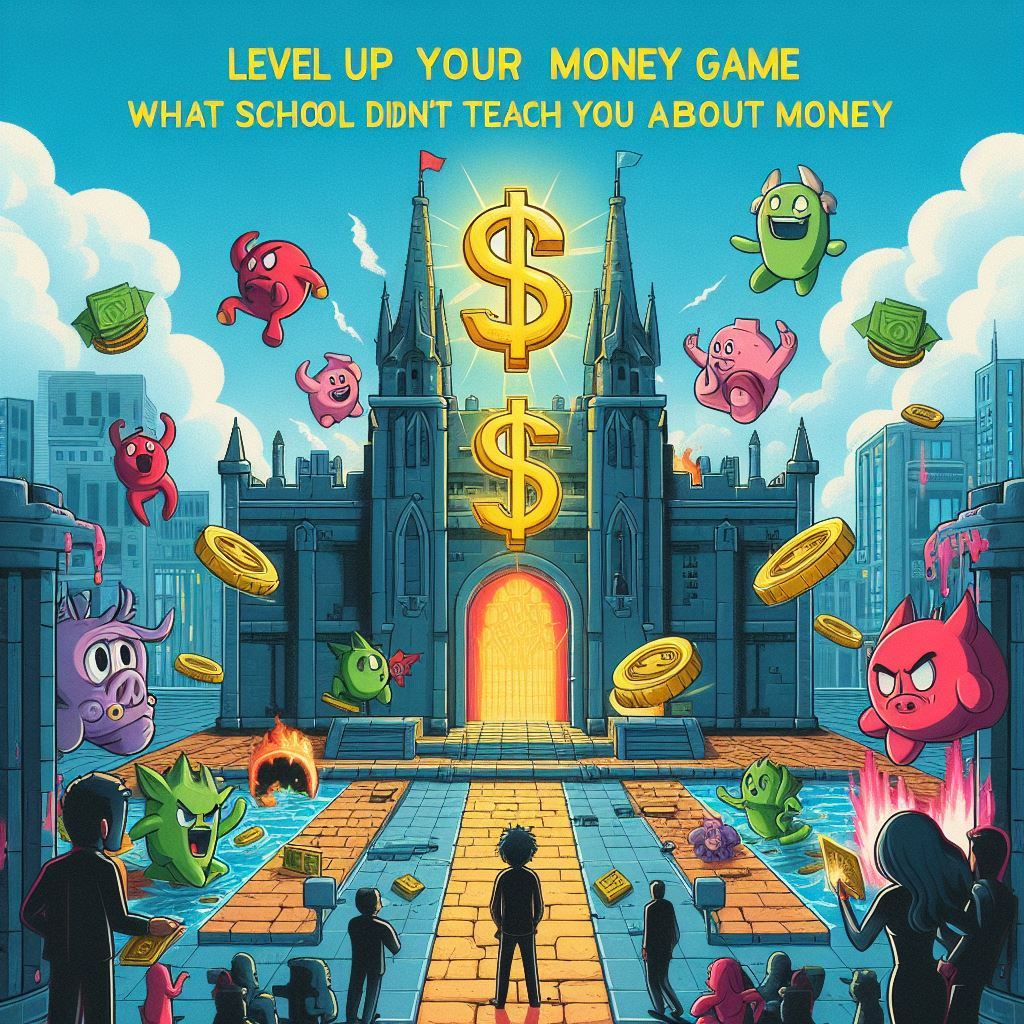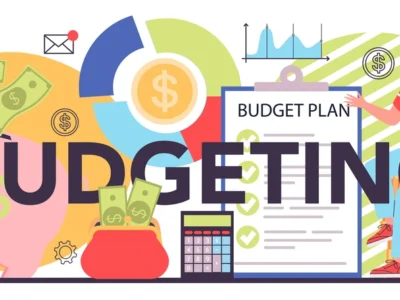Level Up Your Money Game: Unlearn & Learn with “What School Didn’t Teach You About Money”.
Tired of financial struggles? This blog exposes the gaps in school education and equips you with powerful money tools. Break free from financial stress and build a thriving future!
In the year 2003, the world witnessed a surprising twist in the narrative of one of the most iconic figures in sports history – professional boxer and heavyweight champion Mike Tyson. Despite his prowess in the ring and a career that had amassed a staggering $300 million, Tyson found himself at the crossroads of financial ruin, declaring bankruptcy.
This unexpected turn of events raised profound questions about the nature of wealth, success, and, most importantly, our understanding of money. At the pinnacle of his career, Tyson faced a daunting $30 million debt, leaving pundits and fans alike perplexed. How could someone who had generated immense wealth find themselves on the brink of financial collapse?
The Mike Tyson Dilemma serves as a poignant reminder that accumulating wealth is only part of the wealth equation. It forces us to confront the pervasive issue of our collective ability to manage the wealth we acquire. Tyson’s story prompts us to reflect on the deeper implications of our relationship with money and poses a crucial question – what is the true essence of financial success if it eludes even those who have tasted victory in the ring?
As we delve into the intricacies of personal finance, Tyson’s journey becomes a symbolic prologue, inviting us to explore the complexities that lie beneath the surface of our monetary pursuits. The unfolding narrative seeks to unravel the mysteries surrounding our financial decisions and aspirations, drawing inspiration from the unexpected financial saga of a once-undefeated champion.
What is Money to You?

Money, in its essence, serves as a multifaceted tool that extends beyond its physical or digital form. It is not merely a medium of exchange but a representation of value within a complex web of human interactions.
Here’s a nuanced exploration of what money truly signifies:
Medium of Exchange:
Money, at its most basic level, acts as a facilitator of trade. It serves as a universally accepted medium of exchange, allowing individuals to trade goods and services efficiently without resorting to cumbersome barter systems.
Store of Value:
Beyond facilitating transactions, money acts as a store of value. It enables individuals to save and accumulate wealth over time. This function is crucial for economic stability and personal financial planning.
Unit of Account:
Money provides a common unit of account, allowing for the standardized measurement of value. Prices, wages, and other economic transactions are expressed in monetary terms, creating a standardized framework for economic communication.
Symbol of Trust:
The acceptance of money relies heavily on trust. Whether in the form of physical currency or digital transactions, individuals trust that money holds value and can be exchanged for goods and services. This trust forms the bedrock of modern economic systems.
Expression of Value:
Money is, fundamentally, an expression of value. When making a purchase, individuals exchange money because they perceive the value of the item or service to be equivalent to the amount spent. This intrinsic link between money and value underscores its significance in human decision-making.
Impact on Behavior:
The role of money extends into the realm of human behaviour. It influences choices, motivates actions, and, at times, becomes a measure of success or status. Understanding the psychological aspects of money is crucial in comprehending its profound impact on individuals and societies.
Morality and Perception:
Money often carries moral connotations. The age-old saying, “money is the root of all evil,” reflects a perception that links wealth to moral character. However, recognizing money as a neutral tool allows for a more nuanced understanding – it is the actions and choices surrounding money that shape its moral implications.
Freedom and Options:
In a broader context, money provides a sense of freedom and a multitude of options. Financial resources empower individuals to make choices aligned with their goals, whether it be pursuing education, starting a business, or enjoying leisure activities.
Money is a dynamic and multifaceted concept. While it serves practical functions in economic systems, its impact transcends the transactional realm, influencing human behaviour, shaping societal structures, and embodying the complex interplay of value and trust in our interconnected world.
Production vs. Consumption

Money, the lifeblood of our financial existence, flows through a delicate dance between production and consumption. This section unveils the intricate dynamics of this balancing act, shedding light on the key elements that shape our financial landscape.
Understanding the Flow:
Money enters our lives predominantly through production, often manifested as the result of our labour – a job. This influx of earnings, a direct reflection of the value we contribute to society, forms the foundation of our financial stability.
Conversely, money exits our lives through consumption, representing the choices we make in spending our hard-earned income.
Consumer Behavior Analysis:
Consider a moment of introspection. Reflect on the money that has flowed into your life and the channels through which it has departed. How much of it remains in your possession today?
This examination unveils the intricate web of consumer behaviour, highlighting the impact of our spending habits on our financial well-being.
Unveiling the Imbalance:
Examining statistics reveals a prevalent issue – a substantial percentage of individuals, even those with higher incomes, live paycheck to paycheck. The paradox emerges: individuals earning six figures annually may find themselves struggling due to an imbalance between consumption and production. It challenges the assumption that earning more automatically equates to financial security.
The Consumption Conundrum:
The crux of the matter often lies in our consumption patterns. A CareerBuilder study exposed that a significant portion of high-earning Americans still live paycheck to paycheck. This prompts a crucial question: when earning well above average wages, why do many succumb to financial instability? The answer often lies in unchecked consumption, where lifestyle inflation outpaces income growth.
Identifying the Culprit:
While it’s easy to attribute financial woes solely to inadequate income, a deeper analysis reveals that consumption habits play a pivotal role. The root cause of financial instability often lies in overspending, overlooking the importance of saving and investing for the future. Addressing this issue requires a recalibration of our relationship with consumption.
Living on the Financial Edge:
Living paycheck to paycheck isn’t just a financial challenge; it’s a lifestyle trap. The fear of losing a job or facing unexpected expenses becomes a constant companion. This precarious situation transforms a job from a choice to a necessity, as it becomes the sole means to sustain the current lifestyle or manage existing debts.
Escape Routes:
Breaking free from this cycle begins with awareness. Journaling monthly expenses categorically – housing, transportation, food, utilities, entertainment – provides a roadmap for understanding consumption habits. However, overcoming behavioural biases, such as the ostrich effect (avoiding negative financial information), becomes a critical step in facing financial realities.
Budgeting for Control:
A structured budget emerges as a powerful tool in regaining control. Deciding monthly allocations for each category ensures a conscious approach to spending. This systematic evaluation of consumption patterns empowers individuals to live below their means, creating room for saving and investing.
Emergency Fund as a Lifeline:
Before delving into investments, building an emergency fund stands as a prerequisite. This financial safety net, comprising three to six months’ worth of expenses, acts as a shield against unforeseen circumstances, providing a buffer in times of crisis.
In essence, navigating the intricate dance between production and consumption demands a conscious effort to rebalance the scales. By understanding the nuances of personal financial habits, individuals can pave the way toward financial stability, breaking free from the perpetual cycle of living on the financial edge.
Escaping the Money Trap

The term “rat race” takes on a vivid reality when one finds themselves teetering on the financial edge. Living paycheck to paycheck, one unexpected expense away from turmoil paints a daunting picture.
This section delves into the intricacies of escaping the money trap, offering insights into both the psychological and strategic facets of achieving financial freedom.
The Rat Race:
Visualize a constant struggle to keep up with financial responsibilities, where any unforeseen circumstance threatens to unravel the carefully woven financial stability. This is the rat race – an exhausting pursuit, where the moment money enters your life, it seems to vanish, leaving a perpetual feeling of financial vulnerability.
The Psychological Toll:
Living on the financial edge not only endangers your financial position but also takes a toll on your mental well-being. The fear of job loss or an unexpected event creates a mindset where the job ceases to be a choice; it becomes an absolute necessity to sustain the existing lifestyle or service debts.
Confronting the Ostrich Effect:
Addressing the root of the issue begins with confronting the ostrich effect – the natural tendency to avoid negative financial information. This avoidance, akin to refusing to check your bank account after a night out, hinders progress. Acknowledging the financial realities is the first step towards regaining control.
Journaling Expenses:
The journey out of the money trap commences with self-awareness. Journaling monthly expenses categorically – housing, transportation, food, utilities, entertainment – provides a tangible record of where the money flows. This exercise, though challenging, is essential to unravelling spending patterns and identifying areas for improvement.
Budgeting for Control:
A structured budget acts as a compass in navigating financial waters. Allocating specific amounts for each category ensures intentional spending. This systematic approach empowers individuals to live below their means, fostering a lifestyle that allows for both saving and investing.
Emergency Fund as a Lifeline:
Before venturing into the realm of investments, establishing an emergency fund becomes paramount. This financial safety net, typically holding three to six months’ worth of expenses, serves as a cushion against unexpected setbacks, offering stability in times of crisis.
Behavioural Finance Challenges:
The journey to financial stability encounters hurdles rooted in behavioural finance. The ostrich effect is just one challenge; hyperbolic discounting, favoring short-term rewards over long-term gains, and social proof, succumbing to societal spending norms, present additional obstacles. Overcoming these biases requires a conscious effort to reshape financial perspectives.
Living Below Your Means:
The key to escaping the money trap lies in adopting a lifestyle that leaves room for saving and investing. Living below your means involves making intentional choices that prioritize financial well-being over instant gratification. It’s a shift from chasing the next paycheck to building a sustainable and secure financial future.
Breaking the Cycle:
A budget, coupled with an emergency fund and an understanding of behavioural biases, serves as a potent combination to break free from the financial rat race. It’s about transforming financial habits, resisting societal pressures, and making choices aligned with long-term goals.
Escaping the money trap requires not just financial acumen but a profound shift in mindset. By navigating the challenges posed by consumer behaviour and addressing the psychological aspects of financial decision-making, individuals can chart a course towards lasting financial freedom.
Production: Making Money Moves

Transitioning from the intricacies of personal finance, this section explores the proactive side of wealth creation – production. While frugality and budgeting dominate discussions in financial circles, understanding how to increase income is equally vital. “Making Money Moves” delves into avenues beyond traditional employment, shedding light on various means of production that can elevate one’s financial standing.
Entrepreneurial Routes:
Entrepreneurship emerges as a powerful means of production, transcending the traditional job paradigm. Creating a business that addresses a market need allows for the exponential growth of one’s production capacity. The entrepreneurial journey involves identifying problems, crafting solutions, and scaling those solutions to reach a broader audience.
Scaling Production Through Business:
Successful businesses operate as engines of production, generating substantial value for society. The ability to scale production through a business not only amplifies earnings but also provides a platform for sustained growth. Entrepreneurs like Graham Stephan and Dave Ramsey exemplify the potential of scaling production through innovative ventures.
Utilizing Online Platforms:
The internet has democratized production, offering platforms for individuals to create and disseminate value on a massive scale. YouTube, as demonstrated by content creators like Graham Stephan, becomes a vehicle for producing content that resonates with a wide audience. These online endeavours showcase how non-traditional production methods can yield significant returns.
Finding Your Production Niche:
Production extends beyond the conventional definition of starting a business. It involves recognizing personal skills, talents, and passions that can be transformed into value for others.
Whether it’s creating an app, developing software, or establishing a fitness brand, finding one’s niche in production is key to sustained success.
Job as a Form of Production:
While entrepreneurship offers a robust path, traditional employment also constitutes a form of production. The key lies in understanding one’s unique skills and maximizing their value within the job market. This approach involves continuous skill development and strategic career moves to enhance production potential.
The Internet’s Role in Production:
The digital age has revolutionized how production reaches the masses. Online platforms not only facilitate content creation but also provide avenues for freelancers, creatives, and professionals to showcase their skills. The ability to produce and market one’s talents online broadens the scope of income-generating possibilities.
Financial Influencers as Producers:
Personal finance channels, exemplified by influencers like Graham Stephan, serve as both educators and producers. Beyond imparting financial wisdom, these influencers leverage platforms like YouTube to create content that resonates with a vast audience. Their ability to produce valuable insights positions them as influential figures in the financial landscape.
Acknowledging Diverse Production Avenues:
While traditional advice often emphasizes frugality and saving, acknowledging diverse production avenues is crucial. Influencers like Graham Stephan and Dave Ramsey underscore the importance of making money moves beyond mere expense reduction. Recognizing the array of possibilities enables individuals to tailor their production strategies to their unique strengths.
In essence, making money moves involves expanding the production side of the financial equation. Whether through entrepreneurship, online ventures, or maximizing one’s skills in the job market, understanding diverse production avenues opens up new horizons for wealth creation.
This section encourages individuals to embrace a multifaceted approach to financial success, where increasing income becomes an integral part of the wealth-building narrative.
Conclusion: What School Didn’t Teach You About Money
Awareness as consumers and producers sets the stage for a holistic approach to money management. By understanding the value we bring to the market and balancing consumption with production, we can escape the perpetual rat race.
This journey concludes with gratitude for the viewer’s engagement and recommendations for further exploration into personal finance and entrepreneurship literature.
Discover more from Digital Wealth Guru
Subscribe to get the latest posts sent to your email.










Comments